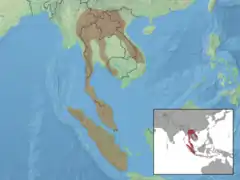| Rhizomys sumatrensis[1] | |||
| (Raffles, 1821) | |||
 | |||
| Systematyka | |||
| Domena | |||
|---|---|---|---|
| Królestwo | |||
| Typ | |||
| Podtyp | |||
| Gromada | |||
| Podgromada | |||
| Infragromada | |||
| Rząd | |||
| Podrząd | |||
| Infrarząd | |||
| Nadrodzina | |||
| Rodzina | |||
| Podrodzina | |||
| Plemię | |||
| Rodzaj | |||
| Gatunek |
bambusowiec indomalajski | ||
| Synonimy | |||
|
| |||
| Podgatunki | |||
| |||
| Kategoria zagrożenia (CKGZ)[9] | |||
 | |||
| Zasięg występowania | |||
 | |||
Bambusowiec indomalajski[10], bambusowiec[11] (Rhizomys sumatrensis) – gatunek ssaka z podrodziny bambusowców (Rhizomyinae) w obrębie rodziny ślepcowatych (Spalacidae). W polskiej literaturze zoologicznej dla oznaczenia gatunku R. sumatrensis używana była nazwa zwyczajowa „bambusowiec”[11]. Jednak w wydanej w 2015 roku przez Muzeum i Instytut Zoologii Polskiej Akademii Nauk publikacji „Polskie nazewnictwo ssaków świata” gatunkowi temu przypisano oznaczenie bambusowiec indomalajski, rezerwując nazwę bambusowiec dla rodzaju Rhizomys[10].
Zasięg występowania
Bambusowiec indomalajski występuje w południowo-wschodniej Azji zamieszkując w zależności od podgatunku[12]:
- R. sumatrensis sumatrensis – południowy Półwysep Malajski na południe od Seberang Perai (Malezja).
- R. sumatrensis cinereus – wschodnia Mjanma, południowy Junnan (Chińska Republika Ludowa), Tajlandia, Laos, Wietnam, zachodnia Kambodża i Półwysep Malajski na południe do Pahang (Malezja).
- R. sumatrensis insularis – północno-wschodnia Sumatra.
- R. sumatrensis padangensis – Sumatra.
Taksonomia
Gatunek po raz pierwszy zgodnie z zasadami nazewnictwa binominalnego opisał w 1821 roku brytyjski zoolog Thomas Stamford Raffles nadając mu nazwę Mus sumatrensis[2]. Holotyp pochodził z Malakki, w Malezji[13].
We wcześniejszych ujęciach systematycznych traktowany jako członek podrodzaju Nyctocleptes, ale analizy filogenetyczne wykazały, że wszystkie istniejące gatunki z rodzaju Rhizomys są bardzo blisko spokrewnione[14][12]. Rozmieszczenie podgatunków jest słabo rozgraniczone, więc mogą występować liczne gatunki[12]. Autorzy Illustrated Checklist of the Mammals of the World rozpoznają cztery podgatunki[12].
Etymologia
- Rhizomys: gr. ῥιζα rhiza „korzeń”; μυς mus, μυος muos „mysz”[15].
- sumatrensis: Sumatra, Indonezja[16].
- cinereus: łac. cinereus „popielatoszary, koloru popiołu”, od cinis, cineris „prochy, popiół”[16].
- insularis: łac. insularis „z wyspy, wyspowy”, od insula, insulae „wyspa”[16].
- padangensis: Padang, Sumatra, Indonezja[8].
Morfologia
Długość ciała (bez ogona) 260–480 mm, długość ogona 100–200 mm; masa ciała 2,1–4 kg[17].
Przypisy
- ↑ Rhizomys sumatrensis, [w:] Integrated Taxonomic Information System (ang.).
- 1 2 T.S. Raffles. Descriptive Catalogue of a Zoological Collection, made on account of the Honourable East India Company, in the Island of Sumatra and its Vicinity, under the Direction of Sir Thomas Stamford Raffles, Lieutenant-Governor of Fort Marlborough; with additional Notices illustrative of the Natural History of those Countries. „Transactions of the Linnean Society of London”. 13, s. 258, 1821. (ang.).
- ↑ G. Cuvier: Le règne animal distribué d’après son organisation, pour servir de base a l’histoire naturelle des animaux et d’introduction a l’anatomie comparée. Wyd. Nouvelle édition rev. et aug. T. 1. Paris: Chez Déterville, 1829, s. 211. (fr.).
- ↑ C.J. Temminck. Monographie over een nieuw geslacht van knaagdier, onder den naam van Nyctocleptes. „Bijdragen aan de Natuurkundige Wetenschappen”. 7 (1), s. 7, 1832. (niderl.).
- ↑ J. McClelland. On collections. „Calcutta Journal of Natural History”. 2, s. 456, 1842. (ang.).
- ↑ J. Anderson. On a Bamboo-rat. „Proceedings of the Asiatic Society of Bengal”. 1877, s. 150, 1877. (ang.).
- ↑ O. Thomas. Notes on the Asiatic bamboo-rats (Rhizomys, etc.). „The Annals and Magazine of Natural History”. Eight series. 16, s. 58, 1915. (ang.).
- 1 2 L.D. Brongersma. On the subspecies of Rhizomys sumatrensis (Raffles) with some notes on related species. „Zoologische mededeelingen”. 19 (12), s. 154, 1936. (ang.).
- ↑ K. Aplin & D. Lunde, Rhizomys sumatrensis, [w:] The IUCN Red List of Threatened Species 2016, wersja 2021-2 [dostęp 2021-11-05] (ang.).
- 1 2 Nazwy polskie za: W. Cichocki, A. Ważna, J. Cichocki, E. Rajska-Jurgiel, A. Jasiński & W. Bogdanowicz: Polskie nazewnictwo ssaków świata. Warszawa: Muzeum i Instytut Zoologii PAN, 2015, s. 231. ISBN 978-83-88147-15-9. (pol. • ang.).
- 1 2 Z. Kraczkiewicz: SSAKI. Wrocław: Polskie Towarzystwo Zoologiczne – Komisja Nazewnictwa Zwierząt Kręgowych, 1968, s. 81, seria: Polskie nazewnictwo zoologiczne.
- 1 2 3 4 C.J. Burgin, D.E. Wilson, R.A. Mittermeier, A.B. Rylands, T.E. Lacher & W. Sechrest: Illustrated Checklist of the Mammals of the World. Cz. 1: Monotremata to Rodentia. Barcelona: Lynx Edicions, 2020, s. 326. ISBN 978-84-16728-34-3. (ang.).
- ↑ D.E. Wilson & D.M. Reeder (redaktorzy): Species Rhizomys sumatrensis. [w:] Mammal Species of the World. A Taxonomic and Geographic Reference (Wyd. 3) [on-line]. Johns Hopkins University Press, 2005. [dostęp 2021-11-05].
- ↑ R. López-Antoñanzas, L.J. Flynn & F. Knoll. A comprehensive phylogeny of extinct and extant Rhizomyinae (Rodentia): evidence for multiple intercontinental dispersals. „Cladistics”. 29 (3), s. 247–273, 2013. DOI: 10.1111/j.1096-0031.2012.00426.x. (ang.).
- ↑ T.S. Palmer. Index Generum Mammalium: a List of the Genera and Families of Mammals. „North American Fauna”. 23, s. 608, 1904. (ang.).
- 1 2 3 The Key to Scientific Names, J.A. Jobling (red.), [w:] Birds of the World, S.M. Billerman et al. (red.), Cornell Lab of Ornithology, Ithaca (ang.).
- ↑ R. Norris: Family Spalacidae (Muroid Mole-rats). W: D.E. Wilson, R.A. Mittermeier & T.E. Lacher (redaktorzy): Handbook of the Mammals of the World. Cz. 7: Rodents II. Barcelona: Lynx Edicions, 2017, s. 135–136. ISBN 978-84-16728-04-6. (ang.).